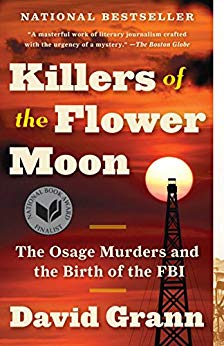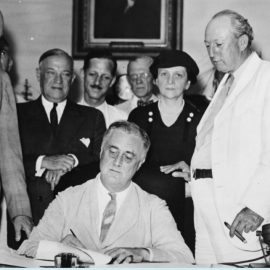

This article is an excerpt from the Shortform summary of "Killers of the Flower Moon" by David Grann. Shortform has the world's best summaries of books you should be reading.
Like this article? Sign up for a free trial here .
Who was Charles Whitehorn? What’s his role in Killers of the Flower Moon?
Charles Whitehorn was an Osage man who lived in Oklahoma in the 1920s. About a week after the murder of Osage woman Anna Brown, Whitehorn’s body was found. Ruled a homicide, the killing was part of the larger conspiracy of the tragic Osage murders.
Read more to learn about Charles Whitehorn and the infamous conspiracy of which he was a victim.
Charles Whitehorn’s Murder
On May 27, 1921, the partially decomposed body of a 25-year-old Osage woman named Anna Brown was discovered in a ravine in Osage County, Oklahoma, dead from a bullet to the back of the head. Anna would be merely one of the first victims in a five-year-long Reign of Terror that would run from 1921 to 1926 and claim the lives of dozens (and possibly hundreds) of Osage men, women, and children.
But Anna’s murder was to be just the beginning. About a week after her body was discovered, another Osage victim was found near an oil rig. This time, the corpse belonged to a man named Charles Whitehorn, who had been missing for about two weeks. Charles Whitehorn was a well-known and popular figure in Osage County, married to a half-white, half-Cheyenne woman. Like Anna Brown, he had been shot in the head—and the bullets appeared to be the same kind as the ones that had killed Anna Brown.
The execution-style murders of two Osage, coming so quickly on the heels of one another, became a prominent story in the local news, as speculation began to mount about who could be responsible. The similar method of killing suggested a link between the two murders, as did their proximity in space and time.
Confusion and Conspiracy
Mollie testified to the local justice of the peace that she had last seen Anna in the company of her brother-in-law, Bryan Burkhart. Bryan testified that he had dropped Anna off at home early in the evening, after which he’d gone back into town. The authorities even briefly detained both Bryan and Ernest Burkhart, though the evidence against them at this time was purely circumstantial and they were soon released.
But there were competing theories about who the murderer could be, given the chaos and lawlessness that defined Osage County. The undeveloped wilderness of the area made it a prominent hideout for all manner of bandits, fugitives, and outlaws. Moreover, many unscrupulous characters had been drawn to the area by the oil money, making the county a hotbed of forgers, scam artists, and gangs of armed robbers.
In this environment, there was no shortage of red herrings, as unsavory informants with ulterior motives provided investigators with false leads. One man, a convicted and imprisoned forger, initially confessed to the crime. He claimed that he had been paid by Anna’s ex-husband to murder her and dump her body in the ravine. But officials quickly concluded that the man’s confession was false—he hadn’t been in the county at the time and had had no known contact with the ex-husband, who also had a proven alibi. The forger later confessed that he had made his story up, hoping to secure better prison conditions.
Other rumors surfaced that Anna’s slaying was part of a love triangle gone bad, with some of these rumors even positing a romantic relationship between Anna Brown and the other murder victim, Charles Whitehorn. Investigators pursued these leads, but they, too, proved to be lies.
Investigators thought they had a break in the case when they discovered that someone had placed a phone call to Anna’s house on the night she disappeared, with the call coming from a business in the nearby town of Ralston. But no operator in Ralston had any record of such a call. Authorities suspected that someone had arranged to have the phone records falsified to throw investigators off.
By July 1921, the local authorities wrapped up the investigation, concluding that Anna was murdered by “parties unknown.” They had surrendered the quest for justice for Anna. And that same month, another tragedy befell Mollie Brown when her mother, Lizzie, died from her wasting illness, so similar to how Minnie had died a few years before—and to how many other healthy Osage seemed to have died of unexplained wasting sicknesses in recent months.
Bill Smith, a white man and the husband of Mollie’s sister, Rita, found the circumstances of Lizzie’s death to be highly suspicious. He began to believe that she and other Osage had been deliberately poisoned, and that her death was linked to those of Anna Brown and Charles Whitehorn.
In February 1922, nine months after the bodies of Anna Brown and Charles Whitehorn were discovered, a fit and healthy 29-year-old Osage man named William Stepson suddenly dropped dead. Authorities concluded that he had died of strychnine poisoning. Poison was an ideal way to commit murder in a remote locale like Osage County, with incompetent professional law enforcement professionals and a coroner untrained in forensics, without access to a crime lab.
The spate of mysterious poisonings of Osage men and women continued into July 1923. The community was, rightly, terrified. These were clearly not random homicides—the tribe was clearly being targeted by a well-orchestrated and coordinated campaign of murder.
Charles Whitehorn was one of the many Osage that tragically lost their lives at the hands of William Hale and his fellow conspirators. Charles Whitehorn’s murder marks the beginning of a defining American tragedy.

———End of Preview———
Like what you just read? Read the rest of the world's best summary of David Grann's "Killers of the Flower Moon" at Shortform .
Here's what you'll find in our full Killers of the Flower Moon summary :
- How the Osage tribe had vast oil wealth, but had it seized by their murderous neighbors
- The brutal and unresolved murders of Osage Native Americans
- The complicated history of the FBI in profiting from the Osage murders






